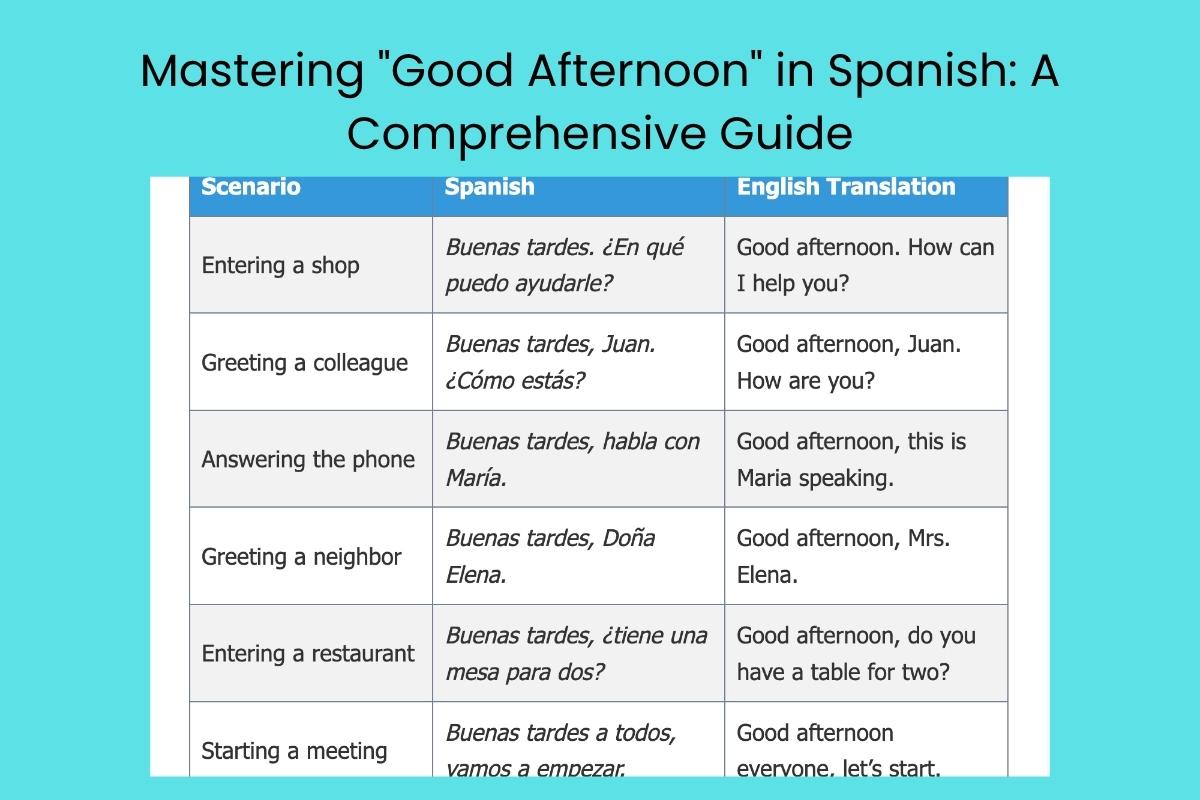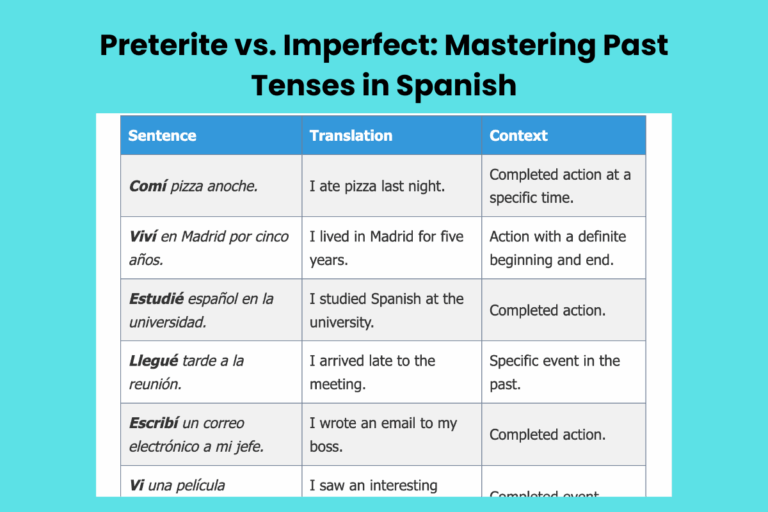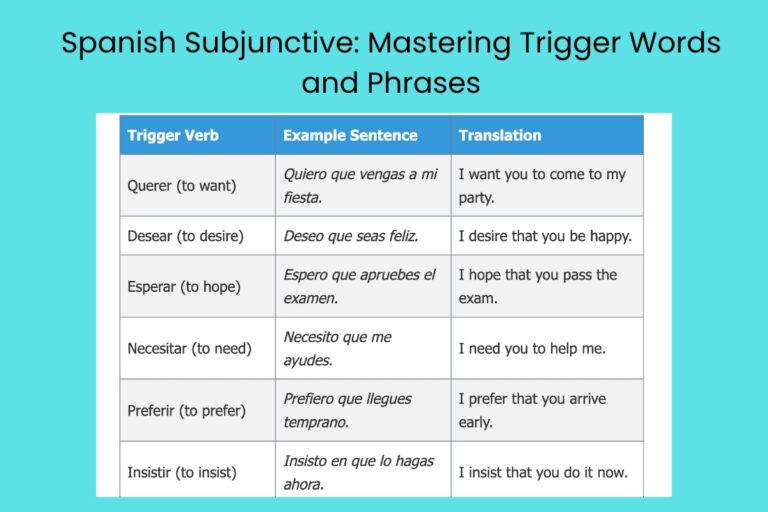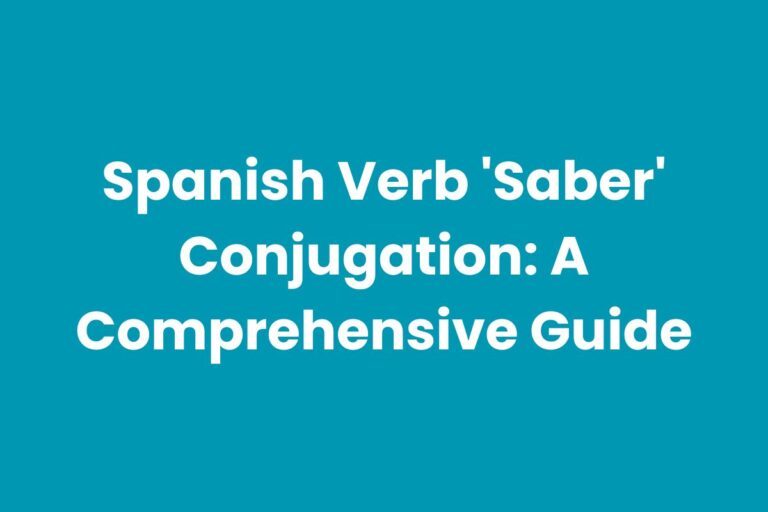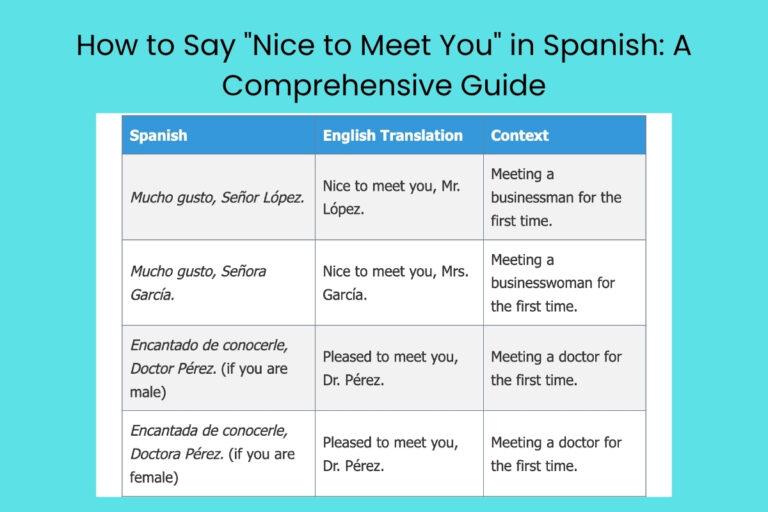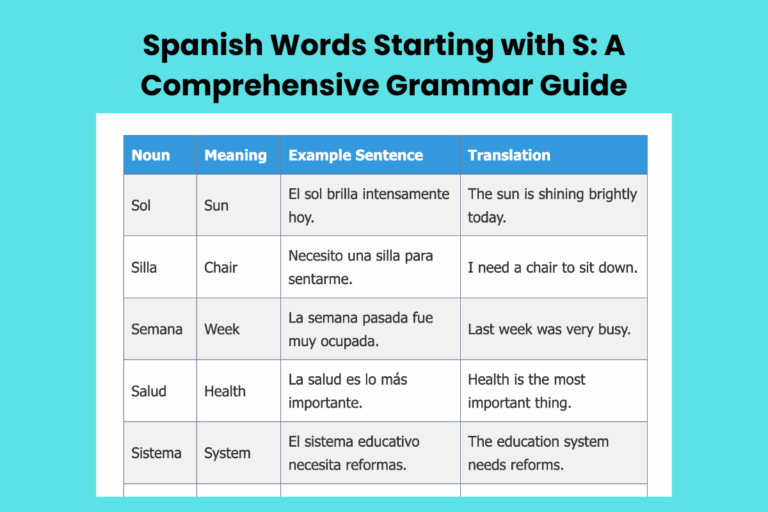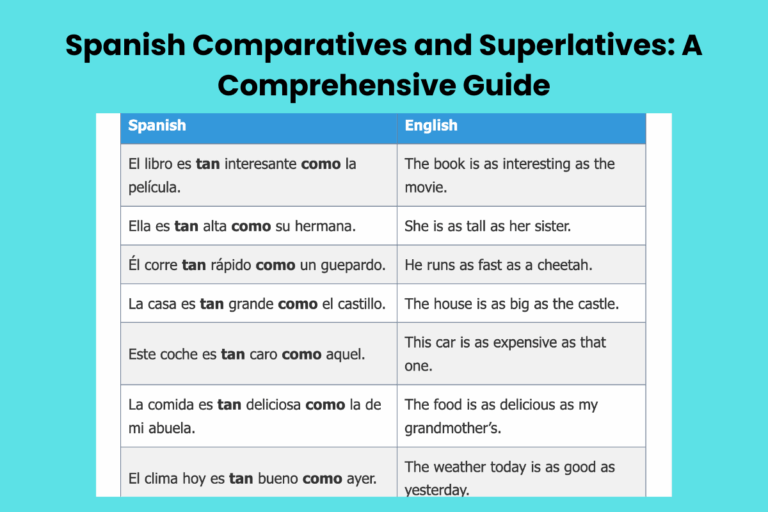Mastering “Good Afternoon” in Spanish: A Comprehensive Guide
Learning to say “good afternoon” in Spanish is a crucial step in mastering basic greetings and showing respect in Spanish-speaking cultures. This simple phrase opens doors to polite conversations and helps you navigate social interactions with confidence.
Whether you’re a beginner or an advanced learner, understanding the nuances of “good afternoon” – including its variations, appropriate contexts, and common mistakes – will significantly enhance your Spanish communication skills. This article provides a comprehensive guide to “good afternoon” in Spanish, covering everything from its definition and structure to usage rules and practice exercises.
Table of Contents
- Introduction
- Definition of “Good Afternoon” in Spanish
- Structural Breakdown of Buenas Tardes
- Variations of “Good Afternoon”
- Examples of Using Buenas Tardes
- Usage Rules for Buenas Tardes
- Common Mistakes When Using Buenas Tardes
- Practice Exercises
- Advanced Topics
- Frequently Asked Questions
- Conclusion
Definition of “Good Afternoon” in Spanish
The most common way to say “good afternoon” in Spanish is Buenas tardes. This phrase is a standard greeting used from noon until sunset. It is considered polite and appropriate in most formal and informal situations. Understanding the etymology and proper usage of Buenas tardes is essential for effective communication in Spanish.
The phrase Buenas tardes consists of two words: Buenas and tardes. Buenas is the feminine plural form of the adjective bueno, which means “good.” Tardes is the plural form of the noun tarde, which means “afternoon” or “evening.” Therefore, Buenas tardes translates literally to “good afternoons,” acknowledging the extended period of time that encompasses the afternoon and early evening.
Classification and Function
Buenas tardes functions as a greeting. It’s used to acknowledge someone’s presence and initiate a conversation politely. It falls under the category of polite expressions and is crucial for establishing positive social interactions.
The phrase can also be used as a farewell in some contexts, although it is more commonly used as a greeting. The use of Buenas tardes indicates respect and consideration for the person being addressed, making it an indispensable part of Spanish etiquette.
Contexts of Use
Buenas tardes is appropriate in a wide range of situations, including:
- Entering a store or business
- Greeting colleagues or acquaintances
- Starting a conversation with someone you don’t know well
- Answering the phone in the afternoon
- Addressing a group of people
It is suitable for both formal and informal settings, although in very informal situations among close friends or family, other greetings might be preferred (e.g., Hola). However, using Buenas tardes is always a safe and respectful choice.
Structural Breakdown of Buenas Tardes
Understanding the structure of Buenas tardes helps to solidify its meaning and usage. The phrase is composed of an adjective and a noun, both in the plural feminine form. This grammatical agreement is crucial for the correct construction of the phrase.
Buenas: The Adjective
Buenas is the feminine plural form of the adjective bueno (good). In Spanish, adjectives must agree in gender and number with the nouns they modify. Since tardes is a feminine plural noun, the adjective must also be feminine and plural.
The adjective bueno can also take other forms depending on the noun it modifies:
- Bueno (masculine singular): Un buen día (A good day)
- Buena (feminine singular): Una buena tarde (A good afternoon)
- Buenos (masculine plural): Buenos días (Good morning)
- Buenas (feminine plural): Buenas tardes (Good afternoon/evening), Buenas noches (Good night)
Tardes: The Noun
Tardes is the plural form of the noun tarde, which means “afternoon” or “evening.” The plural form is used because the greeting encompasses the entire period of the afternoon and early evening, rather than a specific moment.
The noun tarde is feminine, which is why the adjective buenas is used. The concept of time periods, such as afternoon or evening, are often treated as feminine in Spanish.
Grammatical Agreement
The grammatical agreement between buenas and tardes is a fundamental aspect of Spanish grammar. Adjectives must always agree in gender and number with the nouns they modify. This agreement ensures that the phrase is grammatically correct and understandable.
Incorrect examples:
- Bueno tardes (incorrect, adjective does not agree in gender)
- Buena tardes (incorrect, adjective does not agree in number)
- Buenos tarde (incorrect, adjective does not agree in both gender and number)
Understanding this grammatical agreement will help learners avoid common mistakes and construct grammatically correct sentences in Spanish.
Variations of “Good Afternoon”
While Buenas tardes is the standard way to say “good afternoon” in Spanish, there are some variations and related expressions that can be used in specific contexts. These variations may convey different levels of formality or add additional information to the greeting.
Formal Variations
In very formal situations, you might add a title or honorific after the greeting. For example:
- Buenas tardes, Señor (Good afternoon, Sir)
- Buenas tardes, Señora (Good afternoon, Madam)
- Buenas tardes, Doctor (Good afternoon, Doctor)
These formal variations are used to show respect, especially when addressing someone older than you or someone in a position of authority.
Informal Alternatives
In informal settings, you can use a simpler greeting like Hola (Hello) instead of Buenas tardes. However, Buenas tardes is still perfectly acceptable and shows politeness.
Sometimes, people might use Qué tal? (What’s up?) or Cómo estás? (How are you?) after saying Buenas tardes to initiate a conversation.
Regional Differences
While Buenas tardes is universally understood in Spanish-speaking countries, there might be slight regional variations in usage or preference. For example, in some regions, people might switch to Buenas noches (Good evening/night) earlier than in others.
It’s always a good idea to listen to native speakers and observe how they use these greetings in different contexts to get a better understanding of regional preferences.
Examples of Using Buenas Tardes
To fully understand how to use Buenas tardes, it’s helpful to see it in various contexts. The following tables provide examples of different scenarios where you might use this greeting.
General Use Examples
This table shows examples of general use of Buenas tardes in various situations.
| Scenario | Spanish | English Translation |
|---|---|---|
| Entering a shop | Buenas tardes. ¿En qué puedo ayudarle? | Good afternoon. How can I help you? |
| Greeting a colleague | Buenas tardes, Juan. ¿Cómo estás? | Good afternoon, Juan. How are you? |
| Answering the phone | Buenas tardes, habla con María. | Good afternoon, this is Maria speaking. |
| Greeting a neighbor | Buenas tardes, Doña Elena. | Good afternoon, Mrs. Elena. |
| Entering a restaurant | Buenas tardes, ¿tiene una mesa para dos? | Good afternoon, do you have a table for two? |
| Starting a meeting | Buenas tardes a todos, vamos a empezar. | Good afternoon everyone, let’s start. |
| Addressing a teacher | Buenas tardes, Profesor Gómez. | Good afternoon, Professor Gomez. |
| Meeting someone new | Buenas tardes, mucho gusto en conocerte. | Good afternoon, nice to meet you. |
| Entering a doctor’s office | Buenas tardes, tengo una cita a las tres. | Good afternoon, I have an appointment at three. |
| Greeting the mailman | Buenas tardes, gracias por la correspondencia. | Good afternoon, thank you for the mail. |
| Talking to a store clerk | Buenas tardes, ¿dónde puedo encontrar…? | Good afternoon, where can I find…? |
| Seeing a friend in the street | Buenas tardes, ¡qué sorpresa verte por aquí! | Good afternoon, what a surprise to see you here! |
| Entering a library | Buenas tardes, estoy buscando un libro sobre… | Good afternoon, I am looking for a book about… |
| Talking to a receptionist | Buenas tardes, necesito hablar con el gerente. | Good afternoon, I need to speak with the manager. |
| At a cafe | Buenas tardes, me gustaría un café con leche. | Good afternoon, I would like a latte. |
| When visiting someone’s home | Buenas tardes, gracias por invitarme. | Good afternoon, thank you for inviting me. |
| Starting a presentation | Buenas tardes a todos, hoy les voy a hablar sobre… | Good afternoon everyone, today I am going to talk about… |
| When you arrive at work | Buenas tardes, ya estoy aquí. | Good afternoon, I’m here. |
| When you are asking for help | Buenas tardes, ¿podría ayudarme, por favor? | Good afternoon, could you help me, please? |
| When acknowledging someone’s service | Buenas tardes, excelente servicio. | Good afternoon, excellent service. |
| After a long day | Buenas tardes, qué día tan largo. | Good afternoon, what a long day. |
| When meeting someone formally | Buenas tardes, es un placer conocerlo. | Good afternoon, it’s a pleasure to meet you. |
These examples show the versatility of Buenas tardes and how it can be used in everyday situations.
Formal Context Examples
This table illustrates the use of Buenas tardes in more formal settings.
| Scenario | Spanish | English Translation |
|---|---|---|
| Addressing a government official | Buenas tardes, Señor Ministro. | Good afternoon, Mr. Minister. |
| Speaking to a company CEO | Buenas tardes, Señora Directora. | Good afternoon, Madam Director. |
| Greeting a judge | Buenas tardes, Señor Juez. | Good afternoon, Mr. Judge. |
| Talking to a diplomat | Buenas tardes, Señor Embajador. | Good afternoon, Mr. Ambassador. |
| At a formal event | Buenas tardes, es un honor estar aquí. | Good afternoon, it’s an honor to be here. |
| Addressing a university president | Buenas tardes, Señor Rector. | Good afternoon, Mr. President. |
| Greeting a high-ranking military officer | Buenas tardes, Señor General. | Good afternoon, Mr. General. |
| Talking to a senior academic | Buenas tardes, Doctora Ramírez. | Good afternoon, Dr. Ramirez. |
| When you are attending a formal meeting | Buenas tardes, gracias por la invitación a esta importante reunión. | Good afternoon, thank you for the invitation to this important meeting. |
| When corresponding with a formal client | Buenas tardes, le escribo en referencia a… | Good afternoon, I am writing to you in reference to… |
| Addressing a religious leader | Buenas tardes, Reverendísimo Padre. | Good afternoon, Reverend Father. |
| In a ceremony | Buenas tardes, distinguidos invitados. | Good afternoon, distinguished guests. |
| Speaking to a head of state | Buenas tardes, Señor Presidente. | Good afternoon, Mr. President. |
| When addressing a formal audience | Buenas tardes a todos los presentes. | Good afternoon to everyone present. |
| Beginning a lecture | Buenas tardes, hoy discutiremos… | Good afternoon, today we will discuss… |
| When addressing a formal letter | Buenas tardes, estimado colega. | Good afternoon, dear colleague. |
| When greeting a judge in court | Buenas tardes, Su Señoría. | Good afternoon, Your Honor. |
| During a formal presentation | Buenas tardes, les presentaré los resultados… | Good afternoon, I will present the results… |
| When speaking at an official function | Buenas tardes, agradezco su atención a este evento… | Good afternoon, I appreciate your attention to this event… |
| When addressing a formal panel | Buenas tardes, miembros del panel… | Good afternoon, members of the panel… |
These examples illustrate the importance of using appropriate titles and honorifics in formal settings.
Conversational Examples
This table shows how Buenas tardes can be used in conversational settings, often followed by additional questions or comments.
| Scenario | Spanish | English Translation |
|---|---|---|
| Meeting a friend | Buenas tardes, ¿cómo te va? | Good afternoon, how’s it going? |
| Asking about someone’s day | Buenas tardes, ¿qué tal tu día? | Good afternoon, how was your day? |
| Making plans | Buenas tardes, ¿tienes planes para esta tarde? | Good afternoon, do you have plans for this afternoon? |
| Asking for information | Buenas tardes, ¿sabes a qué hora abre la tienda? | Good afternoon, do you know what time the store opens? |
| Starting a casual conversation | Buenas tardes, ¡qué calor hace hoy! | Good afternoon, it’s so hot today! |
| Catching up with someone | Buenas tardes, ¿qué has hecho últimamente? | Good afternoon, what have you been up to lately? |
| Inviting someone for coffee | Buenas tardes, ¿te gustaría tomar un café? | Good afternoon, would you like to have coffee? |
| Offering help | Buenas tardes, ¿necesitas ayuda con algo? | Good afternoon, do you need help with anything? |
| Asking about someone’s health | Buenas tardes, ¿cómo te sientes hoy? | Good afternoon, how are you feeling today? |
| Discussing the weather | Buenas tardes, parece que va a llover. | Good afternoon, it looks like it’s going to rain. |
| Making small talk | Buenas tardes, ¿viste el partido ayer? | Good afternoon, did you see the game yesterday? |
| Sharing news | Buenas tardes, tengo una noticia que contarte. | Good afternoon, I have some
Usage Rules for Buenas TardesUsing Buenas tardes correctly involves understanding the specific times of day when it is appropriate and adhering to cultural norms. Here are some essential usage rules to keep in mind: Time of DayBuenas tardes is generally used from noon (12:00 PM) until sunset. The exact time when you switch from Buenas tardes to Buenas noches (Good evening/night) can vary depending on the region and the time of year. In many Spanish-speaking countries, people start using Buenas noches around 6:00 PM or 7:00 PM, but this can change based on when it gets dark. FormalityBuenas tardes is appropriate in both formal and informal situations. It is a polite and respectful greeting suitable for most contexts. In very informal situations among close friends or family, you might opt for a more casual greeting like Hola (Hello). However, using Buenas tardes is always a safe and polite option. Cultural ContextIn some cultures, it is considered rude not to greet people when you enter a room or start a conversation. Using Buenas tardes is a sign of respect and good manners. Always pay attention to the cultural context and adapt your greetings accordingly. Observing how native speakers use these phrases will help you navigate social situations more effectively. ResponseWhen someone greets you with Buenas tardes, a simple and polite response is to return the greeting by saying Buenas tardes as well. You can also add a follow-up question or comment, such as ¿Cómo estás? (How are you?) or ¿Qué tal? (What’s up?). Rule: Use Buenas tardes from noon until sunset. Always be polite and respectful, and observe cultural norms to ensure appropriate usage. Common Mistakes When Using Buenas TardesEven though Buenas tardes is a relatively simple phrase, learners can sometimes make mistakes. Here are some common errors to avoid: Gender and Number AgreementOne of the most common mistakes is using the wrong form of the adjective bueno. Remember that buenas is the feminine plural form, so it must agree with the feminine plural noun tardes. Examples of incorrect usage:
Correct usage:
Incorrect Time of DayUsing Buenas tardes at the wrong time of day is another common mistake. Be sure to use it from noon until sunset, and switch to Buenas noches in the evening. Example of incorrect usage:
Over- or Under-Using FormalityWhile Buenas tardes is generally appropriate in most situations, it’s important to gauge the level of formality required. In very informal settings, a simple Hola might be more appropriate, while in formal settings, adding a title or honorific is a good idea. Example of inappropriate usage:
Note: Pay attention to gender and number agreement, use the phrase at the correct time of day, and adjust the level of formality to avoid common mistakes. Practice ExercisesTo reinforce your understanding of Buenas tardes, try the following exercises: Exercise 1: Fill in the BlanksComplete the following sentences with the correct form of “good afternoon”:
Answers:
Exercise 2: Correct the MistakesIdentify and correct the mistakes in the following sentences:
Corrections:
Exercise 3: Role-PlayingImagine you are in the following situations. What would you say?
Possible answers:
Advanced TopicsFor those looking to deepen their understanding of Spanish greetings, here are some advanced topics to explore: Regional Variations in GreetingsExplore how greetings vary across different Spanish-speaking regions. Some regions may have unique expressions or preferences for certain greetings. For example, in some Latin American countries, you might hear expressions like Qué hubo or Qué onda in informal settings. The Etymology of Spanish GreetingsDelve into the etymology of Spanish greetings to understand their historical roots and cultural significance. Understanding the origins of these phrases can provide deeper insights into the Spanish language and culture. For instance, the word hola comes from the German word “halon,” which means “to call.” The Use of Greetings in Literature and FilmAnalyze how greetings are used in Spanish literature and film to convey character, setting, and tone. Pay attention to the specific greetings used by different characters and how they contribute to the overall narrative. For example, a formal greeting might be used to emphasize the distance between two characters, while an informal greeting might indicate a close relationship. Frequently Asked QuestionsWhen should I use Buenas tardes versus Buenas noches?Use Buenas tardes from noon until sunset. Once it gets dark, typically around 6:00 PM or 7:00 PM, switch to Buenas noches. Is it okay to use Hola instead of Buenas tardes?Yes, Hola is a general greeting that can be used in many situations, especially informal ones. However, Buenas tardes is more polite and appropriate in formal settings. How do I respond when someone greets me with Buenas tardes?The simplest response is to return the greeting by saying Buenas tardes as well. You can also add a follow-up question or comment, such as ¿Cómo estás? (How are you?). Can I use Buenas tardes as a farewell?While it is more commonly used as a greeting, Buenas tardes can also be used as a farewell in some contexts, especially when you know you won’t see the person again until the next afternoon. What if I’m not sure what time it is?If you’re unsure whether to use Buenas tardes or Buenas noches, it’s generally safer to use Buenas tardes. It’s considered polite and respectful in most situations. ConclusionMastering the phrase Buenas tardes is an essential step in learning to communicate effectively in Spanish. By understanding its definition, structure, variations, and usage rules, you can confidently use this greeting in a variety of situations. Remember to pay attention to cultural context, avoid common mistakes, and practice regularly to improve your fluency. With these tips, you’ll be well-equipped to greet others with politeness and respect in the Spanish-speaking world. |

